|
AI/ML - PHY - Positioning
AI/ML is needed for positioning in cellular networks to enhance accuracy, especially in complex environments like urban areas where traditional methods may struggle due to factors like building density and multipath interference. AI/ML can learn from vast amounts of data to discern patterns and make predictions, improving the reliability of positioning. These techniques can also adapt to changes in the environment and help in scenarios where line-of-sight to satellites or towers is obstructed.
The ability of AI/ML to process and make sense of diverse and noisy data is invaluable for the future of positioning in 5G and beyond.
AI/ML Direct Positioning vs AI/ML Assisted Positioning
There are roughly two different approaches to positioning using AI/ML : AI/ML Direct Positioning and AI/ML Assisted Positioning as summarized in the illustration below.
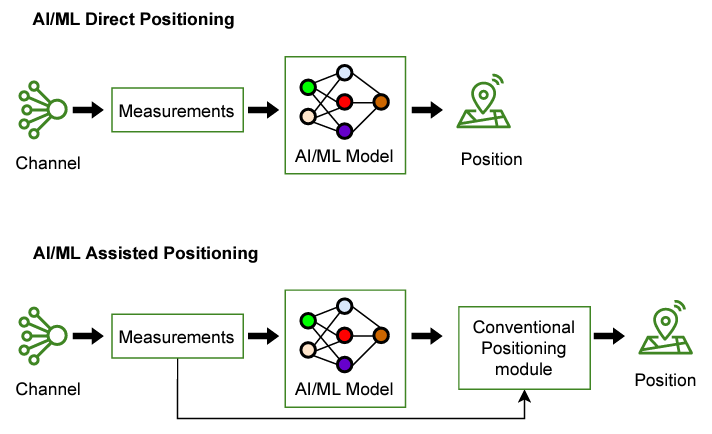
Image Source : 5G Positioning Advancements with AI/ML
-
In AI/ML Direct Positioning, measurements from the channel are fed into an AI/ML model, which then directly outputs the position. This method bypasses traditional steps, relying solely on the AI/ML model's capability to deduce the position from the raw data. Direct positioning in 5G aims to figure out exactly where devices are, especially when they can't see satellites or towers clearly, like in big cities. The challenge is making this work well no matter where you are,
with whatever phone you have, and even as technology gets better over time. Plus, since places change and technology in phones gets outdated, we need to keep teaching the system so it stays smart and accurate. This all has to be figured out without making it too tough for phone companies to use different tech or asking too much from your phone's hardware.
- Motivations:
- To enhance location accuracy, especially where traditional methods like GPS struggle.
- To adapt to complex urban environments with obstacles that disrupt clear signal paths.
- To leverage the processing power of modern devices for real-time positioning.
- Challenges:
- Ensuring reliable performance across varied scenarios and different devices.
- Balancing the demand for high accuracy with constraints in computational power.
- Keeping up with continuous advancements in technology and updating systems accordingly.
- Monitoring AI/ML model performance to ensure accuracy over time.
- Handling data collection sensitively to respect privacy and minimize intrusiven
- In AI/ML Assisted Positioning, the process also starts with channel measurements input into an AI/ML model. However, instead of outputting the position directly, the AI/ML model's output is used to enhance or refine the data for a conventional positioning module. This traditional module then computes the final position, potentially with higher accuracy or reliability thanks to the AI/ML's preprocessing. This hybrid approach merges AI/ML insights with established
positioningalgorithms. This method is about enhancing the traditional positioning process with AI/ML insights rather than replacing it. The challenges for Assisted Positioning would likely include ensuring the AI/ML assistance integrates seamlessly with existing systems, managing the additional computational load, and maintaining the balance between AI/ML enhancements and the proven reliability of established positioning methods.
- Motivations
- To improve the precision of traditional positioning systems by preprocessing data.
- To adapt to varying signal conditions that might affect positioning accuracy.
- To benefit from the established reliability of conventional methods while enhancing performance with AI/ML insights.
- Challenges
- Integrating AI/ML outputs seamlessly with existing positioning algorithms.
- Balancing the computational demands of AI/ML processing without draining device resources.
- Ensuring the AI/ML model's updates do not disrupt the existing positioning system's operation.
- Maintaining the performance benefits of AI/ML assistance as environmental conditions and user behaviors change.
AI/ML MODEL LIFE CYCLE MANAGEMENT (LCM)
Managing the life cycle of AI/ML models in positioning involves overseeing their entire journey, from initial design to final use. It includes making complex models that can adapt to different environments and devices, ensuring they stay useful and accurate as technologies evolve, and keeping an eye on them to make sure they're performing well over time.
- Model management complexity
-
Adjust AI/ML models to diverse deployment scenarios.
-
Consider compatibility with various vendors' equipment.
-
Plan for future technology advancements and changes.
-
Address the potential performance drop after deployment.
-
Orchestrate services within 5G systems for positioning.
- Data Management
-
Acquire accurate data for training AI/ML models.
-
Validate and preprocess data to suit model requirements.
-
Consider the legal and technical challenges in data collection.
-
Balance the need for comprehensive data against cost and privacy concerns.
- Model training
-
Address the generalizability of models across different environments.
-
Combine training data from various sources to improve model robustness.
-
Use semi-supervised learning techniques when labeled data is limited.
- Model validation
- Model Deployment
- Model Inference
- Model Monitoring and Management
-
Continuously monitor the model's performance.
-
Manage model switching and updating as needed.
-
Implement re-training protocols for significant environmental changes
TDoc gives a lot of insights and intuitive explanations that are not usually provided by TS (Test Specification) but in many cases you may feel difficulties to catch up what a TDoc is talking about unless you tracked down the topics from the beginning. The discussions in TDocs proceed incrementaly and refer to many terms in previous TDocs without the detailed explanations. In order to catch up the document, I would suggest you to give careful readings on several TDocs released at the very early
discussion and get familiar with core concepts and key terminologies. In this section, I want to note those core concepts and terminologies from TDoc based on my personal criteria.
R1-2400145: Discussion on positioning accuracy enhancement for AI/ML
This document is about Positioning Accuracy enhancement with the following objectives.
- Positioning accuracy enhancements, encompassing [RAN1/RAN2/RAN3]:
- Direct AI/ML positioning:
- (1st priority) Case 1: UE-based positioning with UE-side model; direct AI/ML positioning
- (2nd priority) Case 2: UE-assisted/LMF-based positioning with LMF-side model, direct AI/ML positioning
- (1st priority) Case 3b: NG-RAN node assisted positioning with LMF-side model, direct AI/ML positioning
- AI/ML assisted positioning:
- (2nd priority) Case 2a: UE-assisted/LMF-based positioning with UE-side model; AI/ML assisted positioning
- (1st priority) Case 3a: NG-RAN node assisted positioning with gNB-side model; AI/ML assisted positioning
- Specify necessary measurements, signalling mechanism(s) to facilitate LCM(Life Cycle Management) operations specific to the Positioning accuracy enhancements use-cases, if any
- Investigate and specify the necessary signalling of necessary measurement enhancements (if any)
- Enabling method(s) to ensure consistency between training and inference regarding NW-side additional conditions (if identified) for inference at UE for relevant positioning sub-use cases
NOTE : Try to remember the descriptions on each case since they will be referred in other documents without further explanation.
UE side model vs Network side model
As in other use cases (e.g, CSI / Beam management AI/ML), we can think of the Positioning AI/ML in two different types - UE side model and NW side model.
UE side model
This is the case (model) where training and inference is performed on UE. We can break down this process into two steps : Training and Inference as described below.
Model Training
The process involves deciding between using PRUs alone or combining PRUs(Positioning Reference Unit) with UEs for generating labels and measurements essential for AI/ML model training in positioning. The document leans towards using PRUs due to concerns about the accuracy and utility of data from UEs. We can break down this process into smaller pieces as follows :
- Label Generation:
- Primarily requires PRUs.
- UEs are considered only if absolutely necessary and beneficial.
- Measurement Data Generation:
- Involves both PRUs and UEs performing channel measurements using PRS.
- The existing PRS configuration can be used for training data in Case 1.
- Training Location:
- The simplest model training approach is on the UE-side, either within the UE or on an OTT server.
- Training on the network side is a possibility but requires model transfer capabilities, which are not yet supported.
- Data Transfer for Training:
- Transferring labels and measurements to the UE-side training entity is straightforward, especially if PRUs/UEs and the OTT server are from the same vendor.
- Network-assisted data collection (e.g., via LMF) introduces complexities due to the need for defining over-the-air transfer protocols and is considered outside the RAN1 discussion scope.
- Recommendation:
- focus on PRUs for generating labels to avoid the challenges associated with UE-based label generation, questioning the necessity of AI/ML in scenarios where legacy methods suffice.
- defer discussions on network-side model training and focus on implementation methods that allow flexibility in AI/ML model design.
Overall procedure can be summarized into a flow shown below
< Case 1 model training, transfer of measurements and labels from PRU/[UE] to UE-side training entity in a spec transparent manner>
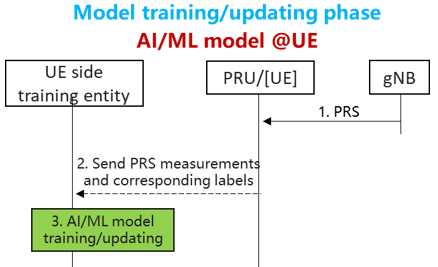
- PRS (Positioning Reference Signals): The gNodeB transmits Positioning Reference Signals. These signals are used for measuring channel properties necessary for accurate positioning.
- Data Transfer: The PRU (Positioning Reference Unit) or the UE collects these PRS measurements and sends them, along with the corresponding labels (information that characterizes the measurements), to the UE side training entity. The labels might indicate the position or other relevant information that the AI/ML model will learn to predict.
- AI/ML Model Training/Updating: Upon receiving this data, the UE side training entity (which could be a component or application within the UE, or an external server that assists in the training process) uses the PRS measurements and labels to train or update the AI/ML model. This is the learning phase where the model attempts to understand and infer patterns from the input data.
Model Inference
< Case 1 model inference - (a) Direct positioning model inference phase>
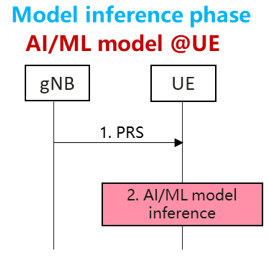
< Case 1 model inference - (b) Assisted positioning model inference phase>
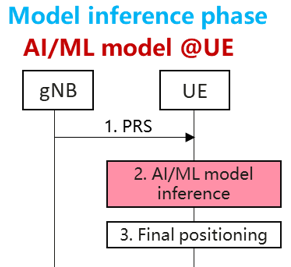
NW side model
This is the case (model) where training and inference is performed on Network. We can break down this process into two steps : Training and Inference as described below.
Model Training
< Case 3a model training >
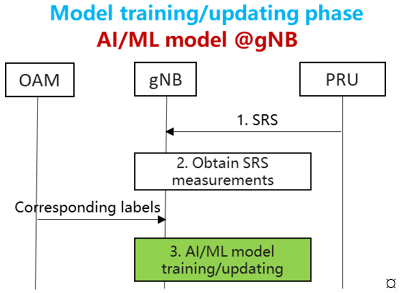
< Case 3b model training, no spec impact on top of inference >
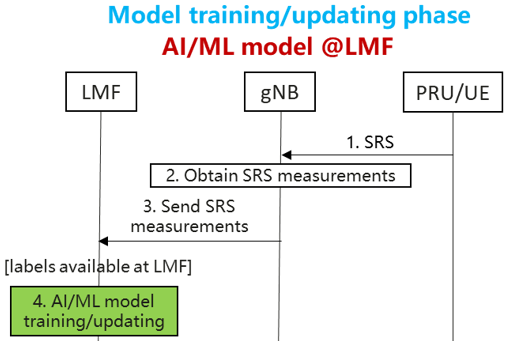
Model Inference
< Case 3a model inference - Assisted positioning model inference phase >
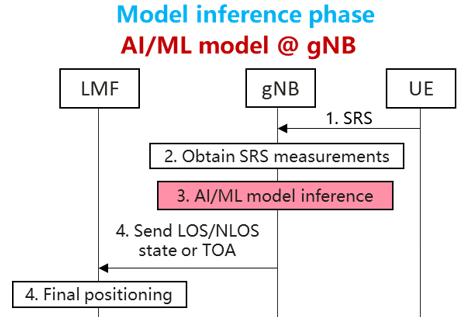
< Case 3b model inference - Direct positioning model inference phase>
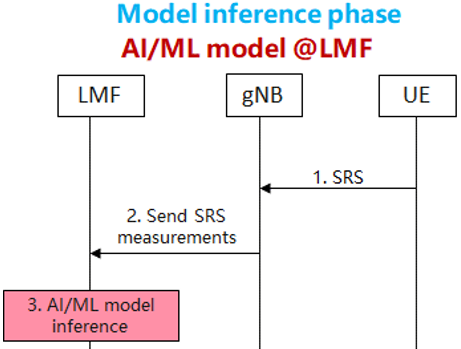
- 3GPP TR/TS/General
- 3GPP TDocs
- TSG RAN WG1 #116
- R1-2401766 : Session notes for 9.1 (Artificial Intelligence (AI)/Machine Learning (ML) for NR Air Interface) - TSG RAN WG1 #116 February 26th March 1st, 2024
- R1-2401599 - FL summary #3 for AI/ML in management : 3GPP TSG RAN WG1 #116 - February 26th March 1st, 2024
- R1-2401598 : FL summary #1 for AI/ML in management - 3GPP TSG RAN WG1 #116 February 26th March 1st, 2024
- R1-2401597 : FL summary #1 for AI/ML in management - 3GPP TSG RAN WG1 #116 February 26th March 1st, 2024
- R1-2401596 : FL summary #1 for AI/ML in management - 3GPP TSG RAN WG1 #116 February 26th March 1st, 2024
- R1-2401573 : Final Summary for other aspects of AI/ML model and data - 3GPP TSG RAN WG1 #116 February 26th March 1st, 2024
- R1-2401572 : Summary #4 for other aspects of AI/ML model and data - 3GPP TSG RAN WG1 #116 February 26th March 1st, 2024
- R1-2401571 : Summary #3 for other aspects of AI/ML model and data - 3GPP TSG RAN WG1 #116 February 26th March 1st, 2024
- R1-2401570 : Summary #2 for other aspects of AI/ML model and data - 3GPP TSG RAN WG1 #116 February 26th March 1st, 2024
- R1-2401569 : Summary #2 for other aspects of AI/ML model and data - 3GPP TSG RAN WG1 #116 February 26th March 1st, 2024
- R1-2401432 : Specification support for AI-ML-based positioning accuracy enhancement - 3GPP TSG RAN WG1 #116 February 26th March 1st, 2024
- R1-2401430 : Work plan for Rel-19 WI on AI and ML for NR air interface - 3GPP TSG RAN WG1 #116 February 26th March 1st, 2024
- R1-2401225 : Discussion on other aspects of AI/ML model and data - 3GPP TSG RAN WG1 #116 February 26th March 1st, 2024
- R1-2401154 : Discussion on Specification Support of AI/ML for Positioning Accuracy Enhancement- 3GPP TSG RAN WG1 #116 February 26th March 1st, 2024
- R1-2401137 : Design for AI/ML based positioning- 3GPP TSG RAN WG1 #116 February 26th March 1st, 2024
- R1-2401042 : Discussion on support for AIML positioning- 3GPP TSG RAN WG1 #116 February 26th March 1st, 2024
- R1-2400845 : Discussions on AI/ML for positioning accuracy enhancement - 3GPP TSG RAN WG1 #116 February 26th March 1st, 2024
- R1-2400794 : AI/ML for Positioning Accuracy Enhancement - 3GPP TSG RAN WG1 #116 February 26th March 1st, 2024
- R1-2400767 : Discussions on specification support for AI/ML positioning accuracy enhancement - 3GPP TSG RAN WG1 #116 February 26th March 1st, 2024
- R1-2400757 : Discussion on AI/ML-based positioning accuracy enhancement - 3GPP TSG RAN WG1 #116 February 26th March 1st, 2024
- R1-2400721 : Discussion for supporting AI/ML based positioning accuracy enhancement - 3GPP TSG RAN WG1 #116 February 26th March 1st, 2024
- R1-2400693 : Specification support for AI-enabled positioning - 3GPP TSG RAN WG1 #116 February 26th March 1st, 2024
- R1-2400619 : On specification for AI/ML-based positioning accuracy enhancements - 3GPP TSG RAN WG1 #116 February 26th March 1st, 2024
- R1-2400544 : Discussion on AI/ML-based positioning accuracy enhancement - 3GPP TSG RAN WG1 #116 February 26th March 1st, 2024
- R1-2400419: Discussion on AI/ML-based positioning accuracy enhancement - 3GPP TSG RAN WG1 #116 February 26th March 1st, 2024
- R1-2400393: ML based Positioning - 3GPP TSG RAN WG1 #116 February 26th March 1st, 2024
- R1-2400377: Specification support for AI/ML for positioning accuracy enhancement - 3GPP TSG RAN WG1 #116 February 26th March 1st, 2024
- R1-2400169: Discussion on specification support for AI/ML positioning accuracy enhancement - 3GPP TSG RAN WG1 #116 February 26th March 1st, 2024
- R1-2400145: Discussion on positioning accuracy enhancement for AI/ML - 3GPP TSG RAN WG1 #116 February 26th March 1st, 2024
- 3GPP TSG-RAN WG1 Meeting #118bis
- R1-2407649 : AI/ML for Positioning Accuracy Enhancement - 3GPP TSG-RAN WG1 Meeting #118bis - October 14th ñ 18th, 2024
- R1-2407654 : Discussion on AI/ML for positioning accuracy enhancement- 3GPP TSG-RAN WG1 Meeting #118bis - October 14th ñ 18th, 2024
- R1-2407657 : Discussion on other aspects of the additional study for AI/ML -3GPP TSG-RAN WG1 Meeting #118bis - October 14th ñ 18th, 2024
- R1-2407697 : Discussion on other aspects of AI/ML model and data-3GPP TSG-RAN WG1 Meeting #118bis - October 14th ñ 18th, 2024
- R1-2407852 : Other aspects of AI/ML model and data -3GPP TSG-RAN WG1 Meeting #118bis - October 14th ñ 18th, 2024
- R1-2407896 : Discussion on other aspects of AI/ML model and data-3GPP TSG-RAN WG1 Meeting #118bis - October 14th ñ 18th, 2024
- R1-2407938 : Discussion on AI/ML beam management-3GPP TSG-RAN WG1 Meeting #118bis - October 14th ñ 18th, 2024
- R1-2407941 : Discussion on other aspects of AI/ML in NR air interface-3GPP TSG-RAN WG1 Meeting #118bis - October 14th ñ 18th, 2024
- R1-2407951 : Discussion on AI/ML-based positioning accuracy enhancement-3GPP TSG-RAN WG1 Meeting #118bis - October 14th ñ 18th, 2024
- R1-2407954 : Further study on AI/ML model and data-3GPP TSG-RAN WG1 Meeting #118bis - October 14th ñ 18th, 2024
- R1-2407989 : ML based Positioning-3GPP TSG-RAN WG1 Meeting #118bis - October 14th ñ 18th, 2024
- R1-2407992 : ML Model and Data - 3GPP TSG-RAN WG1 Meeting #118bis - October 14th ñ 18th, 2024
- R1-2408028 : Discussion on AI/ML-based positioning - 3GPP TSG-RAN WG1 Meeting #118bis - October 14th ñ 18th, 2024
- R1-2408031 : Study on AI/ML for other aspects - 3GPP TSG-RAN WG1 Meeting #118bis - October 14th ñ 18th, 2024
- R1-2408159 : On specification for AI/ML-based positioning accuracy enhancements - 3GPP TSG-RAN WG1 Meeting #118bis - October 14th ñ 18th, 2024
- R1-2408162 : Additional study on other aspects of AI/ML model and data - 3GPP TSG-RAN WG1 Meeting #118bis - October 14th ñ 18th, 2024
- R1-2408222 : Discussion on other aspects of AI/ML model and data - 3GPP TSG-RAN WG1 Meeting #118bis - October 14th ñ 18th, 2024
- R1-2408269 : Discussion on other aspects of AI/ML - 3GPP TSG-RAN WG1 Meeting #118bis - October 14th ñ 18th, 2024
- R1-2408290 : Specification support for AI/ML for positioning accuracy enhancement - 3GPP TSG-RAN WG1 Meeting #118bis - October 14th ñ 18th, 2024
- R1-2408292 : Other aspects of AI/ML model and data - 3GPP TSG-RAN WG1 Meeting #118bis - October 14th ñ 18th, 2024
- R1-2408391 : Specification support for AI-enabled positioning (*)- 3GPP TSG-RAN WG1 Meeting #118bis - October 14th ñ 18th, 2024
- R1-2408394 : Additional study on other aspects of AI model and data(*)- 3GPP TSG-RAN WG1 Meeting #118bis - October 14th ñ 18th, 2024
- R1-2408402 : Support for AI/ML for positioning accuracy enhancement- 3GPP TSG-RAN WG1 Meeting #118bis - October 14th ñ 18th, 2024
- R1-2408429 : Specification impacts for AI/ML Positioning(*)- 3GPP TSG-RAN WG1 Meeting #118bis - October 14th ñ 18th, 2024
- R1-2408432 : Discussion on other aspects of AI/ML model and data - 3GPP TSG-RAN WG1 Meeting #118bis - October 14th ñ 18th, 2024
- R1-2408438: On other aspects of AI/ML model and data - 3GPP TSG-RAN WG1 Meeting #118bis - October 14th ñ 18th, 2024
- R1-2408453: Discussion on specification support for AI/ML-based positioning - 3GPP TSG-RAN WG1 Meeting #118bis - October 14th ñ 18th, 2024
- R1-2408456: Discussion on other aspects of AI/ML model and data - 3GPP TSG-RAN WG1 Meeting #118bis - October 14th ñ 18th, 2024
- R1-2408522: Discussion on support for AI/ML positioning - 3GPP TSG-RAN WG1 Meeting #118bis - October 14th ñ 18th, 2024
- R1-2408541: Discussion on other aspects of AI/ML for air interface - 3GPP TSG-RAN WG1 Meeting #118bis - October 14th ñ 18th, 2024
- R1-2408545: AI/ML for Positioning Accuracy Enhancement - 3GPP TSG-RAN WG1 Meeting #118bis - October 14th ñ 18th, 2024
- R1-2408548: Other aspects of AI/ML for two-sided model use case - 3GPP TSG-RAN WG1 Meeting #118bis - October 14th ñ 18th, 2024
- R1-2408549: Draft LS reply on applicable functionality reporting for AI/ML beam management - 3GPP TSG-RAN WG1 Meeting #118bis - October 14th ñ 18th, 2024
- R1-2408609: Discussion on specification support for AI/ML-based positioning accuracy enhancements - 3GPP TSG-RAN WG1 Meeting #118bis - October 14th ñ 18th, 2024
- R1-2408807 : Discussions on AI/ML for CSI compression - 3GPP TSG-RAN WG1 Meeting #118bis - October 14th ñ 18th, 2024
- R1-2408838 : Specification support for AI-ML-based positioning accuracy enhancement - 3GPP TSG-RAN WG1 Meeting #118bis - October 14th ñ 18th, 2024
- R1-2408841 : Other aspects of AI/ML model and data - 3GPP TSG-RAN WG1 Meeting #118bis - October 14th ñ 18th, 2024
- R1-2408885 : Other aspects of AI/ML model and data - 3GPP TSG-RAN WG1 Meeting #118bis - October 14th ñ 18th, 2024
- R1-2408903 : Design for AI/ML based positioning - 3GPP TSG-RAN WG1 Meeting #118bis - October 14th ñ 18th, 2024
- R1-2408908 : Discussions on specification support for positioning accuracy enhancement for AI/ML - 3GPP TSG-RAN WG1 Meeting #118bis - October 14th ñ 18th, 2024
- R1-2408923 : Discussion on specification support for AI/ML Positioning Accuracy enhancement - 3GPP TSG-RAN WG1 Meeting #118bis - October 14th ñ 18th, 2024
- R1-2408957 : Remaining issues on Rel-18 UE Features - 3GPP TSG-RAN WG1 Meeting #118bis - October 14th ñ 18th, 2024
- R1-2408959 : Specification support for AI/ML beam management - 3GPP TSG-RAN WG1 Meeting #118bis - October 14th ñ 18th, 2024
- R1-2409114 : FL summary #0 for AI/ML in beam management - 3GPP TSG-RAN WG1 Meeting #118bis - October 14th ñ 18th, 2024
- R1-2409115 : FL summary #1 for AI/ML in beam management - 3GPP TSG-RAN WG1 Meeting #118bis - October 14th ñ 18th, 2024
- R1-2409116 : FL summary #2 for AI/ML in beam management - 3GPP TSG-RAN WG1 Meeting #118bis - October 14th ñ 18th, 2024
- R1-2409117 : FL summary #3 for AI/ML in beam management - 3GPP TSG-RAN WG1 Meeting #118bis - October 14th ñ 18th, 2024
- R1-2409118 : FL summary #4 for AI/ML in beam management - 3GPP TSG-RAN WG1 Meeting #118bis - October 14th ñ 18th, 2024
- R1-2409168 : Summary #1 for other aspects of AI/ML model and data - 3GPP TSG-RAN WG1 Meeting #118bis - October 14th ñ 18th, 2024
- R1-2409169 : Summary #2 for other aspects of AI/ML model and data - 3GPP TSG-RAN WG1 Meeting #118bis - October 14th ñ 18th, 2024
- R1-2409170 : Summary #3 for other aspects of AI/ML model and data - 3GPP TSG-RAN WG1 Meeting #118bis - October 14th ñ 18th, 2024
- R1-2409171 : Summary #4 for other aspects of AI/ML model and data - 3GPP TSG-RAN WG1 Meeting #118bis - October 14th ñ 18th, 2024
- R1-2409278 : Summary#3 of AI 9.5.3 for R19 NES - 3GPP TSG-RAN WG1 Meeting #118bis - October 14th ñ 18th, 2024
- R1-2409305 : FL summary #5 for AI/ML in beam management - 3GPP TSG-RAN WG1 Meeting #118bis - October 14th ñ 18th, 2024
- 3GPP TSG-RAN WG1 Meeting #120
- R1-2500015 : Reply LS to SA5 on AIML data collection - 3GPP TSG-RAN WG1 Meeting #120 - February 12thñ16th, 2025
- R1-2500016 : Reply LS to SA2 on AIML data collection - 3GPP TSG-RAN WG1 Meeting #120 - February 12thñ16th, 2025
- R1-2500029 : Reply on AIML data collection - 3GPP TSG-RAN WG1 Meeting #120 - February 12thñ16th, 2025
- R1-2500030 : Reply LS on AIML data collection - 3GPP TSG-RAN WG1 Meeting #120 - February 12thñ16th, 2025
- R1-2500031 : Reply LS on AIML data collection - 3GPP TSG-RAN WG1 Meeting #120 - February 12thñ16th, 2025
- R1-2500052 : Discussion on other aspects of AI/ML model and data on AI/ML for NR air-interface - 3GPP TSG-RAN WG1 Meeting #120 - February 12thñ16th, 2025
- R1-2500060 : AI/ML for Positioning Accuracy Enhancement - 3GPP TSG-RAN WG1 Meeting #120 - February 12thñ16th, 2025
- R1-2500067 : Discussion on AI/ML-based positioning enhancement - 3GPP TSG-RAN WG1 Meeting #120 - February 12thñ16th, 2025
- R1-2500070 : Discussion on other aspects of AI/ML model and data - 3GPP TSG-RAN WG1 Meeting #120 - February 12thñ16th, 2025
- R1-2500090 : Discussion on AI/ML for positioning accuracy enhancement - 3GPP TSG-RAN WG1 Meeting #120 - February 12thñ16th, 2025
- R1-2500152 : Discussion on other aspects of the additional study for AI/ML - 3GPP TSG-RAN WG1 Meeting #120 - February 12thñ16th, 2025
- R1-2500162 : Discussion on other aspects of AI/ML model and data - 3GPP TSG-RAN WG1 Meeting #120 - February 12thñ16th, 2025
- R1-2500202 : Discussion on AI/ML-based positioning - 3GPP TSG-RAN WG1 Meeting #120 - February 12thñ16th, 2025
- R1-2500205 : Further study on AI/ML for other aspects - 3GPP TSG-RAN WG1 Meeting #120 - February 12thñ16th, 2025
- R1-2500255 : Discussion on other aspects of AI ML model and data - 3GPP TSG-RAN WG1 Meeting #120 - February 12thñ16th, 2025
- R1-2500278 : Discussion on other aspects of AI/ML model and data - 3GPP TSG-RAN WG1 Meeting #120 - February 12thñ16th, 2025
- R1-2500341 : Other aspects of AI/ML model and data - 3GPP TSG-RAN WG1 Meeting #120 - February 12thñ16th, 2025
- R1-2500388 : LS on LMF-based AI/ML Positioning for Case 2b - 3GPP TSG-RAN WG1 Meeting #120 - February 12thñ16th, 2025
- R1-2500389 : LS on LMF-based AI/ML Positioning for case 3b - 3GPP TSG-RAN WG1 Meeting #120 - February 12thñ16th, 2025
- R1-2500392 : Discussion on other aspects of AI/ML - 3GPP TSG-RAN WG1 Meeting #120 - February 12thñ16th, 2025
- R1-2500408 : Other aspects of AI/ML Model and Data - 3GPP TSG-RAN WG1 Meeting #120 - February 12thñ16th, 2025
- R1-2500466 : On specification for AI/ML-based positioning accuracy enhancements - 3GPP TSG-RAN WG1 Meeting #120 - February 12thñ16th, 2025
- R1-2500469 : Additional study on other aspects of AI/ML model and data - 3GPP TSG-RAN WG1 Meeting #120 - February 12thñ16th, 2025
- R1-2500518 : Discussion on specification support for AI-ML based positioning accuracy enhancement - 3GPP TSG-RAN WG1 Meeting #120 - February 12thñ16th, 2025
- R1-2500529 : Discussion on AI/ML for beam management - 3GPP TSG-RAN WG1 Meeting #120 - February 12thñ16th, 2025
- R1-2500546 : AI/ML based Positioning - 3GPP TSG-RAN WG1 Meeting #120 - February 12thñ16th, 2025
- R1-2500549 : AI/ML Model and Data - 3GPP TSG-RAN WG1 Meeting #120 - February 12thñ16th, 2025
- R1-2500556 : Discussion on AIML positioning - 3GPP TSG-RAN WG1 Meeting #120 - February 12thñ16th, 2025
- R1-2500559 : Discussions on other aspects of AlML In NR air interface - 3GPP TSG-RAN WG1 Meeting #120 - February 12thñ16th, 2025
- R1-2500568 : Discussion on other aspects of AI/ML model and data - 3GPP TSG-RAN WG1 Meeting #120 - February 12thñ16th, 2025
- R1-2500571 : Discussion on reply LS on LMF-based AI/ML Positioning for Case 2b - 3GPP TSG-RAN WG1 Meeting #120 - February 12thñ16th, 2025
- R1-2500572 : Draft reply LS on LMF-based AI/ML Positioning for Case 3b - 3GPP TSG-RAN WG1 Meeting #120 - February 12thñ16th, 2025
- R1-2500591 : Discussion on other aspects of AI/ML model and data - 3GPP TSG-RAN WG1 Meeting #120 - February 12thñ16th, 2025
- R1-2500606 : Discussion on specification support for AIML based positioning accuracy enhancement - 3GPP TSG-RAN WG1 Meeting #120 - February 12thñ16th, 2025
- R1-2500616 : Discussion on LS on LMF-based AI/ML Positioning for case 3b - 3GPP TSG-RAN WG1 Meeting #120 - February 12thñ16th, 2025
- R1-2500617 : Discussion on LS on LMF-based AI/ML Positioning for Case 2b - 3GPP TSG-RAN WG1 Meeting #120 - February 12thñ16th, 2025
- R1-2500618 : [Draft] Reply LS on LMF-based AI/ML Positioning for Case 2b - 3GPP TSG-RAN WG1 Meeting #120 - February 12thñ16th, 2025
- R1-2500619 : [Draft] Reply LS on LMF-based AI/ML Positioning for Case 3b - 3GPP TSG-RAN WG1 Meeting #120 - February 12thñ16th, 2025
- R1-2500636 : Specification impacts for AI/ML positioning - 3GPP TSG-RAN WG1 Meeting #120 - February 12thñ16th, 2025
- R1-2500638 : On AI/ML for CSI compression - 3GPP TSG-RAN WG1 Meeting #120 - February 12thñ16th, 2025
- R1-2500639 : Discussion on other aspects of AI/ML model and data - 3GPP TSG-RAN WG1 Meeting #120 - February 12thñ16th, 2025
- R1-2500643 : Specification support for AI/ML for positioning accuracy enhancement - 3GPP TSG-RAN WG1 Meeting #120 - February 12thñ16th, 2025
- R1-2500687 : Specification support for AI-enabled positioning - 3GPP TSG-RAN WG1 Meeting #120 - February 12thñ16th, 2025
- R1-2500690 : Additional study on other aspects of AI model and data - 3GPP TSG-RAN WG1 Meeting #120 - February 12thñ16th, 2025
- R1-2500695 : Draft reply LS on LMF-based AI/ML Positioning for Case 2b - 3GPP TSG-RAN WG1 Meeting #120 - February 12thñ16th, 2025
- R1-2500696 : Draft reply LS on LMF-based AI/ML Positioning for Case 3b - 3GPP TSG-RAN WG1 Meeting #120 - February 12thñ16th, 2025
- R1-2500708 : Discussion for SA2 LS on LMF-based AI/ML Positioning for Case 2b - 3GPP TSG-RAN WG1 Meeting #120 - February 12thñ16th, 2025
- R1-2500711 : Discussion on AI/ML-based positioning accuracy enhancement - 3GPP TSG-RAN WG1 Meeting #120 - February 12thñ16th, 20255
- R1-2500714 : Further study on AI/ML model and data - 3GPP TSG-RAN WG1 Meeting #120 - February 12thñ16th, 2025
- R1-2500745 : Discussion for SA2 LS on LMF-based AI/ML Positioning for Case 3b - 3GPP TSG-RAN WG1 Meeting #120 - February 12thñ16th, 2025
- R1-2500746 : Discussion on support for AIML positioning - 3GPP TSG-RAN WG1 Meeting #120 - February 12thñ16th, 2025
- R1-2500767 : Discussion on Specification Support for AI/ML-based positioning - 3GPP TSG-RAN WG1 Meeting #120 - February 12thñ16th, 2025
- R1-2500770 : Discussion on other aspects of AI/ML models and data - 3GPP TSG-RAN WG1 Meeting #120 - February 12thñ16th, 2025
- R1-2500835 : Discussion for supporting AI/ML based positioning accuracy enhancement - 3GPP TSG-RAN WG1 Meeting #120 - February 12thñ16th, 2025
- R1-2500838 : Views on additional study for other aspects of AI/ML model and data - 3GPP TSG-RAN WG1 Meeting #120 - February 12thñ16th, 2025
- R1-2500904 : Discussion on other aspects of AI/ML model and data - 3GPP TSG-RAN WG1 Meeting #120 - February 12thñ16th, 2025
- R1-2500926 : Discussion on specification support for AIML-based positioning accuracy enhancement - 3GPP TSG-RAN WG1 Meeting #120 - February 12thñ16th, 2025
- R1-2500929 : Discussion on other aspects of AI/ML model and data - 3GPP TSG-RAN WG1 Meeting #120 - February 12thñ16th, 2025
- R1-2500962 : Discussion on specification support for AI/ML beam management - 3GPP TSG-RAN WG1 Meeting #120 - February 12thñ16th, 2025
- R1-2500971 : AI/ML for Positioning Accuracy Enhancement - 3GPP TSG-RAN WG1 Meeting #120 - February 12thñ16th, 2025
- R1-2500974 : Other aspects of AI/ML for two-sided model - 3GPP TSG-RAN WG1 Meeting #120 - February 12thñ16th, 2025
- R1-2500976 : Discussion on other aspects of AI/ML model and data - 3GPP TSG-RAN WG1 Meeting #120 - February 12thñ16th, 2025
- R1-2500991 : AI/ML positioning accuracy enhancement - 3GPP TSG-RAN WG1 Meeting #120 - February 12thñ16th, 2025
- R1-2501079 : Other Aspects of AI/ML framework - 3GPP TSG-RAN WG1 Meeting #120 - February 12thñ16th, 2025
- R1-2501131 : Discussion on specification support for AI/ML based positioning accuracy enhancements - 3GPP TSG-RAN WG1 Meeting #120 - February 12thñ16th, 2025
- R1-2501143 : Rapporteur view on higher layer signalling of Rel-19 AI-ML for NR air interface - 3GPP TSG-RAN WG1 Meeting #120 - February 12thñ16th, 2025
- R1-2501145 : Specification support for AI-ML-based positioning accuracy enhancement - 3GPP TSG-RAN WG1 Meeting #120 - February 12thñ16th, 2025
- R1-2501148 : Other aspects of AI/ML model and data - 3GPP TSG-RAN WG1 Meeting #120 - February 12thñ16th, 2025
- R1-2501191 : Discussion on AI/ML for positioning accuracy enhancement - 3GPP TSG-RAN WG1 Meeting #120 - February 12thñ16th, 2025
- R1-2501194 : Discussion on other aspects of AI/ML model and data - 3GPP TSG-RAN WG1 Meeting #120 - February 12thñ16th, 2025
- R1-2501247 : Discussion on Specification Support of AI/ML for Positioning Accuracy Enhancement - 3GPP TSG-RAN WG1 Meeting #120 - February 12thñ16th, 2025
- R1-2501259 : Design for AI/ML based positioning - 3GPP TSG-RAN WG1 Meeting #120 - February 12thñ16th, 2025
- R1-2501273 : Discussion on specification support for AI/ML Positioning Accuracy enhancement - 3GPP TSG-RAN WG1 Meeting #120 - February 12thñ16th, 2025
- R1-2501283 : Discussions on specification support for positioning accuracy enhancement for AI/ML - 3GPP TSG-RAN WG1 Meeting #120 - February 12thñ16th, 2025
- R1-2501302 : Discussion for SA2 LS on LMF-based AI/ML Positioning for Case 2b - 3GPP TSG-RAN WG1 Meeting #120 - February 12thñ16th, 2025
- R1-2501303 : Discussion for SA2 LS on LMF-based AI/ML Positioning for Case 3b - 3GPP TSG-RAN WG1 Meeting #120 - February 12thñ16th, 2025
- R1-2501304 : Draft reply LS on LMF-based AI/ML Positioning for Case 2b - 3GPP TSG-RAN WG1 Meeting #120 - February 12thñ16th, 2025
- R1-2501305 : Draft reply LS on LMF-based AI/ML Positioning for Case 3b - 3GPP TSG-RAN WG1 Meeting #120 - February 12thñ16th, 2025
- R1-2501306 : Draft LS reply on LMF-based AI/ML Positioning for Case 2b - 3GPP TSG-RAN WG1 Meeting #120 - February 12thñ16th, 2025
- R1-2501308 : Draft LS reply on LMF-based AI/ML Positioning for Case 3b - 3GPP TSG-RAN WG1 Meeting #120 - February 12thñ16th, 2025
- R1-2501330 : Discussion on the LS reply to SA2 on AI/ML Positioning of Case 2b - 3GPP TSG-RAN WG1 Meeting #120 - February 12thñ16th, 2025
- R1-2501331 : Discussion on the LS reply to SA2 on AI/ML Positioning of Case 3b - 3GPP TSG-RAN WG1 Meeting #120 - February 12thñ16th, 2025
- General Reading
|
|







